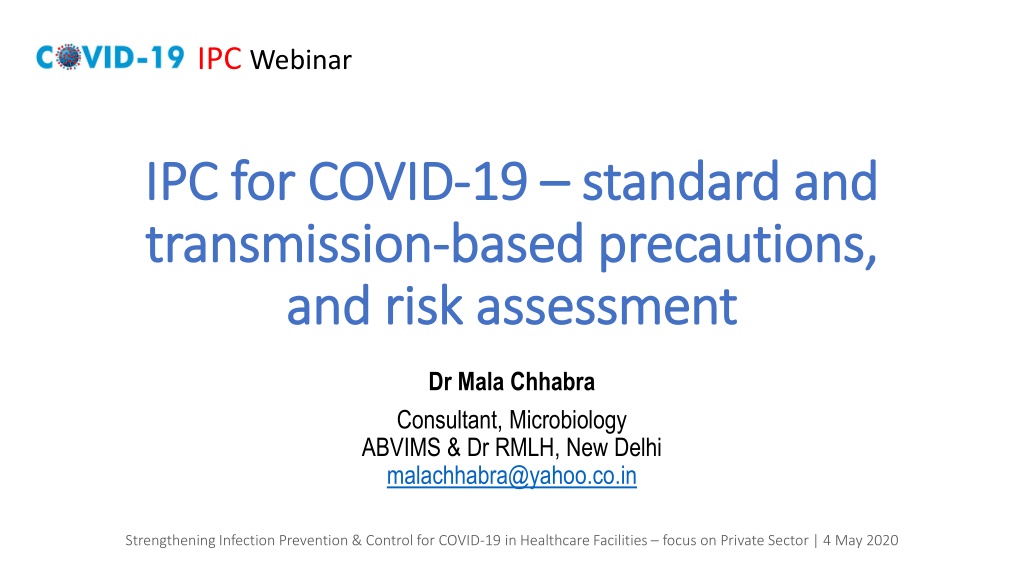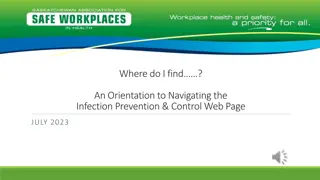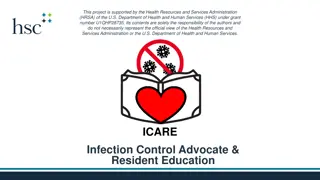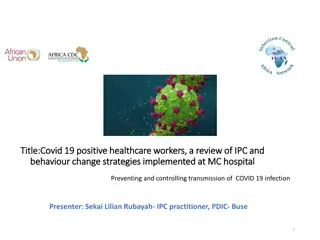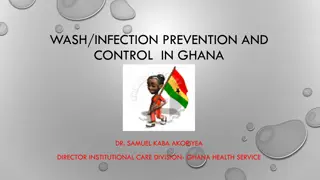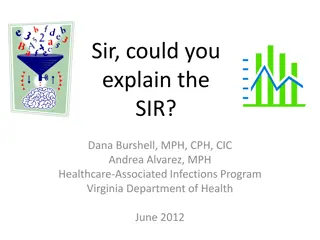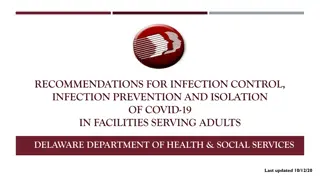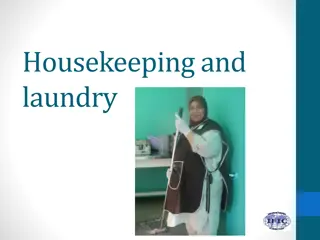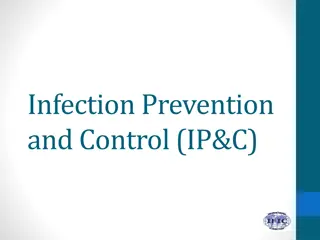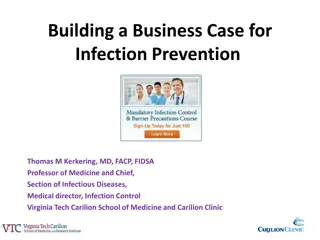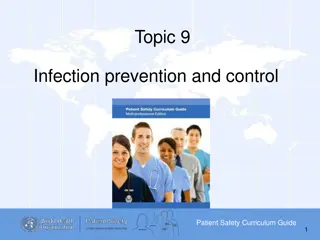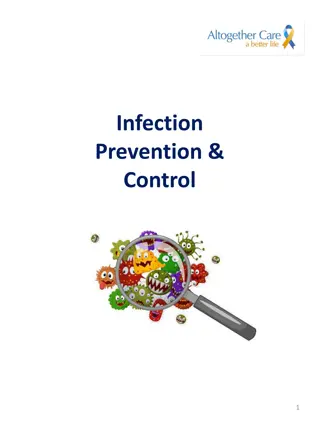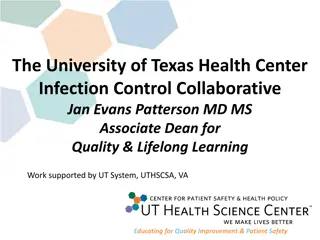Understanding Infection Prevention and Control for COVID-19 in Healthcare
Infection prevention and control aim to prevent harm from infections to patients and healthcare workers, based on scientific principles and patient safety. The content discusses human coronaviruses, modes of transmission, risk factors, and the role of infection prevention in healthcare settings.
Download Presentation

Please find below an Image/Link to download the presentation.
The content on the website is provided AS IS for your information and personal use only. It may not be sold, licensed, or shared on other websites without obtaining consent from the author. Download presentation by click this link. If you encounter any issues during the download, it is possible that the publisher has removed the file from their server.
E N D
Presentation Transcript
IPC Webinar IPC for COVID IPC for COVID- -19 transmission transmission- -based precautions, based precautions, and risk assessment and risk assessment 19 standard and standard and Dr Mala Chhabra Consultant, Microbiology ABVIMS & Dr RMLH, New Delhi malachhabra@yahoo.co.in Strengthening Infection Prevention & Control for COVID-19 in Healthcare Facilities focus on Private Sector | 4 May 2020
Human Coronaviruses Human Coronaviruses Community-acquired HCoVs 1.HCoVs 229E 2.OC43( Organ culture) 3.NL63 (New Heaven Coronaviruses ) 4.HKU-1 SARS (Severe Acute Respiratory Syndrome) CoV 2003 -2004 Middle East respiratory syndrome coronavirus, or MERS CoV - 2012
Novel Coronavirus Novel Coronavirus - - SARS SARS- -CoV CoV- -2 2 Disease COVID 19 Enveloped RNA virus Size: 1.2 microns 4 structural proteins and a strand of RNA S-spike; E-envelope; M-membrane; N-nucleocapsid
Modes of transmission of SAR Modes of transmission of SAR- -CoV CoV- -2 2 Primarily transmitted through Droplet transmission respiratory droplets (>5-10 m) close contact (1 m) Contact Direct with infected patient Indirect fomites Airborne transmission droplet nuclei (<5 m) only during aerosol generating procedures Airborne transmission may be possible in specific circumstances in which procedures or support treatments that generate aerosols are performed e.g. endotracheal incubation, open suctioning, manual ventilation before intubation, non-invasive positive pressure ventilation, tracheostomy and cardiopulmonary resuscitation etc. WHO | Scientific brief | 29 March 2020 | available online
What is infection prevention and control? What is infection prevention and control? Infection prevention and control is a scientific approach with practical solutions designed to prevent harm, caused by infections, to patients and health care workers grounded in principles of infectious disease, epidemiology, social science and health system strengthening, and rooted in patient safety and health service quality Source: WHO Infection Prevention and control web pages;; https://www.who.int/gpsc/ipc/en/
Who is at risk of infection? Who is at risk of infection? Everyone
Benefits of IPC Benefits of IPC Protecting yourself Protecting your patients Protecting your family, community & environment WHO2015 Safe & Quality Health Services Package
IPC goals in outbreak IPC goals in outbreak preparedness preparedness 1. To reduce transmission of health care associated infections 2. To enhance the safety of staff, patients and visitors 3. To enhance the ability of the organization/health facility to respond to an outbreak 4. To lower or reduce the risk of the hospital (health care facility) itself amplifying the outbreak
Role of the IPC focal point, team or committee Role of the IPC focal point, team or committee Knowledge: have an understanding of the IPC strategies needed for outbreaks/epidemics, etc. Assessment, preparedness and readiness Policy and SOPs development Participate in response and recovery Participate in surveillance & monitoring Patient management Infrastructure for patient management Education
IPC strategies for preventing/limiting the IPC strategies for preventing/limiting the spread of COVID spread of COVID- -19 19 Applying standard precautions for all patients Ensuring triage, early recognition, and source control Implementing empiric additional precautions for suspected cases of COVID-19 infection Implementing administrative controls Using environmental and engineering controls
Standard precautions Standard precautions The basic level of IPC precautions, to be used for ALL patients at ALL times regardless of suspected or confirmed status of the patient
Elements of Standard Precautions Elements of Standard Precautions Hand hygiene Respiratory hygiene (etiquette) PPE according to the risk Safe injection practices, sharps management and injury prevention Safe handling, cleaning and disinfection of patient care equipment Environmental cleaning Safe handling and cleaning of soiled linen Waste management
Chain of Transmission Chain of Transmission For an infection to spread, all links must be connected Breaking any one link will stop disease transmission!
Hand Hygiene Hand Hygiene Best way to prevent the spread of germs in the health care setting and community Our hands are our main tool for work as health care workers- and they are the key link in the chain of transmission Door handles Instruments Medication Cellphones Caregivers
Hand hygiene: WHO 5 moments Hand hygiene: WHO 5 moments
Hand hygiene: HOW Hand hygiene: HOW Use appropriate product and technique Alcohol-based hand rub product is preferable, if hands are not visibly soiled Rub hands for 20 30 seconds! Soap, running water and single use towel, when visibly dirty or contaminated with proteinaceous material Wash hands for 40 60 seconds! https://www.who.int/infection-prevention/tools/hand-hygiene/en/
Respiratory hygiene/etiquette Respiratory hygiene/etiquette Reduces the spread of microorganisms (germs) that cause respiratory infections (colds, flu) Turn head away from others when coughing/sneezing Cover the nose and mouth with a tissue. If tissues are used, discard immediately into the trash Cough/sneeze into your sleeve if no tissue is available Clean your hands with soap and water or alcohol based products Do not spit here and there! Image source: https://www.who.int/emergencies/diseases/novel-coronavirus-2019/advice-for-public
Promoting respiratory hygiene Promoting respiratory hygiene Encourage handwashing for patients with respiratory symptoms Provide masks for patients with respiratory symptoms Patients with fever + cough or sneezing should be kept at least 1m away from other patients Post visual aids reminding patients and visitors with respiratory symptoms to cover their cough
PPE for use in health care for COVID PPE for use in health care for COVID- -19 19 Face Mask N95 Mask Face shield Goggle Nose + mouth Nose + mouth Eyes + nose + mouth Eyes Gown Apron Gloves Head cover Body Body Hands Head + hair
Minimize direct unprotected exposure to Minimize direct unprotected exposure to Risk assessment for appropriate use of PPE blood and body fluids blood and body fluids HAND HYGIENE MEDICAL MASK EYE- WEAR SCENARIO GLOVES GOWN Always before and after patient contact, and after contaminated environment If direct contact with blood and body fluids, secretions, excretions, mucous membranes, non-intact skin If there is risk of splashes onto the health care worker s body x x x x x x If there is a risk of splashes onto the body and face x x x x x Rational use of PPE : https://www.mohfw.gov.in/pdf/GuidelinesonrationaluseofPersonalProtectiveEquipment.pdf https://www.mohfw.gov.in/pdf/AdditionalguidelinesonrationaluseofPersonalProtectiveEquipmentsettingapproachforHealthfunctionariesworkinginnonCOVIDareas.pdf
Principles for using PPE (1) Principles for using PPE (1) Always clean your hands before and after wearing PPE PPE should be available where and when it is indicated in the correct size select according to risk or per transmission based precautions Always put on before contact with the patient Always remove immediately after completing the task and/or leaving the patient care area
Principles for using PPE (2) Principles for using PPE (2) Change PPE immediately if it becomes contaminated or damaged PPE should not be adjusted or touched during patient care Specifically Never touch your face while wearing PPE If there is concern and/or breach of these practices, leave the patient care area when safe to do so and properly remove and change the PPE Always remove carefully to avoid self-contamination (from dirtiest to cleanest areas)
Train Train Yourself Yourself Contact Contact IPC Personnel IPC Personnel When in When in doubt doubt- - ASK ASK
PPE PPE Separate areas Buddy Mirror Chair in donning & doffing area (cleanable)
Train Train Yourself Yourself Carefully Carefully Remove PPE Remove PPE for self for self protection protection When in When in doubt doubt- - ASK ASK
The seven steps to safe injections The seven steps to safe injections 1. Clean work space 2. Hand hygiene 3. Sterile safety-engineered syringe 4. Sterile vial of medication and diluent 5. Skin cleaning and antisepsis 6. Appropriate collection of sharps 7. Appropriate waste management https://www.who.int/infection-prevention/tools/injections/training-education/en/
Additional Precautions Additional Precautions
Patients suspected or confirmed COVID Patients suspected or confirmed COVID- -19 (1) 19 (1) Contact and droplet precautions for all patients with suspected or confirmed COVID-19 Airborne precautions are recommended only for aerosol generating procedures (i.e. open suctioning of respiratory tract, intubation, bronchoscopy, cardiopulmonary resuscitation) Preferably patient should be in a single room: Natural ventilation with air flow of at least 160 L/s per patient or Negative pressure rooms with at least 12 air changes per hour and controlled direction of air flow when using mechanical ventilation Cohort all patients with respiratory illness in a single room, or minimum 1m away from other patients when waiting for a room Dedicated & trained HCW HCW to wear PPE: a medical mask, goggles or face shield, gown, and gloves Hand hygiene should be done any time the WHO 5 Moments apply, and before PPE and after removing PPE
Patients suspected or confirmed COVID Patients suspected or confirmed COVID- -19 (2) 19 (2) Equipment should be single use when possible, dedicated to the patient and disinfected between uses Portable machines in hospitals Avoid transporting suspected or confirmed cases if necessary, have patients wear masks; HCW should wear appropriate PPE. Define corridors in the hospital for patient transportation. Routine cleaning of the environment is crucial Limit the number of HCW, visitors, and family members who are in contact with the patient. If necessary, everyone must wear PPE All persons entering patients room (including visitors) should be recorded (for contact tracing) Precautions should continue until the patient is asymptomatic
Outpatient Care Outpatient Care The basic principles of IPC and standard precautions should be applied in all health care facilities, including outpatient care and primary care Triage and early recognition emphasis on hand hygiene, respiratory hygiene and medical masks to be used by patients with respiratory symptoms (consider having signage) if possible place patients in separate rooms or away from other patients in the waiting rooms, and wear mask, gloves and gown if possible when seeing them in the clinic (as much of contact and droplet precautions as possible) when symptomatic patients are required to wait, ensure they have a separate waiting area (1m separation) prioritization of care of symptomatic patients educate patients and families about the early recognition of symptoms, basic precautions to be used and which health care facility they should refer to
Additional Control Measures Additional Control Measures
Administrative Controls Administrative Controls Provision of adequate training for HCWs Ensuring an adequate patient-to-staff ratio Establishing a surveillance process for acute respiratory infections potentially caused by COVID-19 among HCWs Ensuring that HCWs and the public understand the importance of promptly seeking medical care Monitoring HCW compliance with standard precautions and providing mechanisms for improvement as needed
Use of masks Use of masks Use of mask limit spread of certain respiratory diseases Mask alone is insufficient to provide the adequate level of protection and other equally relevant measures should be adopted hand hygiene Wearing medical masks when not indicated may cause unnecessary cost procurement burden create a false sense of security that can lead to neglecting other essential measures such as hand hygiene practices Using a mask incorrectly may hamper its effectiveness to reduce the risk of transmission
Use of masks: healthcare settings Use of masks: healthcare settings Individuals with respiratory symptoms should: Wear a medical mask while waiting in triage or waiting areas or during transportation within the facility Wear a medical mask when staying in cohorting areas dedicated to suspected or confirmed cases Do not wear a medical mask when isolated in single rooms but cover mouth and nose when coughing or sneezing with disposable paper tissues Health care workers should: Wear a medical mask while providing care to the patient Use a particulate respirator N95 (NIOSH certified) , FFP2 (EU standard), or equivalent, when performing aerosol generating procedures (tracheal intubation, non-invasive ventilation, tracheotomy, cardiopulmonary resuscitation, manual ventilation before intubation, and bronchoscopy
Masks management Masks management Place mask carefully to cover mouth and nose and tie securely to minimise any gaps between the face and the mask While in use, avoid touching the mask Remove the mask by using appropriate technique (i.e. do not touch the front but remove the lace from behind) After removal or whenever you inadvertently touch a used mask, clean hands by using an alcohol- based hand rub or soap and water if visibly soiled Replace masks with a new clean, dry mask as soon as they become damp/humid Do not re-use single-use masks Discard single-use masks after each use and dispose of them immediately upon removal
Risk = likelihood and consequences Risk = likelihood and consequences
Risk assessment Risk assessment Risk assessment: risk of exposure and extent of contact anticipated with respiratory droplets, blood, body fluids, and/or open skin Select which PPE items to wear based on this assessment Perform hand hygiene according to the WHO 5 Moments Should be done for each patient, each time Make this routine!
Early identification of Early identification of Healthcare workers/patients Healthcare workers/patients with suspected infection due to COVID with suspected infection due to COVID- -19 19 Establish facility-based surveillance for healthcare-associated infections (HAIs) of all HCWs and admitted patients For HCWs: self monitoring or preferably active monitoring (before every shift) In case a HCW is exposed to infected patient/HCW, quickly do contact tracing Contact person Symptomatic case - any person who has had contact with a COVID-19 case within a time frame ranging from 48 hrs before the onset of symptoms Asymptomatic cases - 48 hrs before the sample which led to confirmation was taken, to 14 days after the onset of symptoms or after the sample was taken. If any contact is found to be symptomatic, immediately restrict from work until medical evaluation is completed
Risk assessment of contact HCWs Risk assessment of contact HCWs Asymptomatic HCW - determine risk category of exposure whether high risk or low risk High risk/close contacts-quarantined and actively monitor for symptoms In no symptoms develop, return to work after 14 days Should symptoms develop, self-isolate immediately and seek medical advice and test for COVID-19 If test negative, return to work after 14 days If test positive, notify for further public health action Low risk contacts to continue to work and monitor for development of symptoms. In case symptoms develop, testing to be done: If test is negative, return to work once symptoms resolved If test is positive, HCW immediately restrict from work, notify case for further public health action HCW infected with COVID-19 may return to work once symptoms have resolved and two samples taken at interval of 24 hrs are negative
Additional precautions to be taken by HCWs Additional precautions to be taken by HCWs For maintaining continuity of operations, staffing plan in place including a contingency plan to handle situations where a HCW has a high risk exposure/develops symptoms and needs to be to be restricted from work To prevent transmission of infection to family members Workplace avoid carrying accessories to workplace like wallets (driving licence and credit card may be carried in Ziploc bag) pens to be kept in lockers at workplace not to carry home, no lanyards etc. thoroughly wash hands, forearms and elbow at the end of the day before leaving workplace Reaching Home must change clothes and wash them minimize physical contact with family members wash hands frequently
Summary Summary IPC is key for containment Based on key principles - hand hygiene, respiratory etiquette, safe distance Hospital infection prevention & control - standard & additional precautions Protect yourself and the community Triage & admissions PPE Judicious and appropriate use Pay attention to donning and doffing Home care precautions
Thank you Thank you
